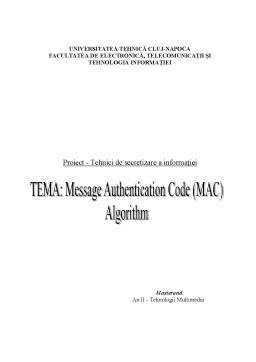Cuprins
- CUPRINS 2
- Introduction 3
- Cryptography 3
- - Symmetric-key cryptography 4
- - Public-key cryptography 5
- But what security goals these algorithms can achieve? 5
- MESSAGE AUTHENTICATION CODE 8
- Definition 8
- Intuition 8
- Concept and Model 10
- Benefits 11
- Design of MAC 12
- Implementation 13
- Security 13
- MAC Algorithm – JAVA implementation example 15
Extras din proiect
Introduction
Cryptography is the practice and study of techniques for secure communication in the presence of third parties (called adversaries). More generally, it is about constructing and analyzing protocols that overcome the influence of adversaries and which are related to various aspects in information security such as data confidentiality, data integrity, authentication, and non-repudiation. Modern cryptography intersects the disciplines of mathematics, computer science, and electrical engineering. Applications of cryptography include ATM cards, computer passwords, and electronic commerce .
Cryptography prior to the modern age was effectively synonymous with encryption, the conversion of information from a readable state to apparent nonsense. The originator of an encrypted message shared the decoding technique needed to recover the original information only with intended recipients, thereby precluding unwanted persons to do the same. Since World War I and the advent of the computer, the methods used to carry out cryptology have become increasingly complex and its application more widespread.
Modern cryptography is heavily based on mathematical theory and computer science practice; cryptographic algorithms are designed around computational hardness assumptions, making such algorithms hard to break in practice by any adversary. It is theoretically possible to break such a system but it is infeasible to do so by any known practical means. These schemes are therefore termed computationally secure; theoretical advances, e.g., improvements in integer factorization algorithms, and faster computing technology require these solutions to be continually adapted. There exist information-theoretically secure schemes that probably cannot be broken even with unlimited computing power – an example is the one-time pad – but these schemes are more difficult to implement than the best theoretically breakable but computationally secure mechanisms.
Before the modern era, cryptography was concerned solely with message confidentiality (i.e., encryption) – conversion of messages from a comprehensible form into an incomprehensible one and back again at the other end, rendering it unreadable by interceptors or eavesdroppers without secret knowledge (namely the key needed for decryption of that message). Encryption was used to (attempt to) ensure secrecy in communications, such as those of spies, military leaders, and diplomats. In recent decades, the field has expanded beyond confidentiality concerns to include techniques for message integrity checking, sender/receiver identity authentication, digital signatures, interactive proofs and secure computation, among others.
The modern field of cryptography can be divided into several areas of study. The chief ones are:
- Symmetric-key cryptography: refers to encryption methods in which both the sender and receiver share the same key (or, less commonly, in which their keys are different, but related in an easily computable way). This was the only kind of encryption publicly known until June 1976.
A significant disadvantage of symmetric ciphers is the key management necessary to use them securely. Each distinct pair of communicating parties must, ideally, share a different key, and perhaps each ciphertext exchanged as well. The number of keys required increases as the square of the number of network members, which very quickly requires complex key management schemes to keep them all consistent and secret. The difficulty of securely establishing a secret key between two communicating parties, when a secure channel does not already exist between them, also presents a chicken-and-egg problem which is a considerable practical obstacle for cryptography users in the real world.
- Public-key cryptography: In a groundbreaking 1976 paper, Whitfield Diffie and Martin Hellman proposed the notion of public-key (also, more generally, called asymmetric key) cryptography in which two different but mathematically related keys are used – a public key and a private key. A public key system is so constructed that calculation of one key (the “private key”) is computationally infeasible from the other (the “public key”), even though they are necessarily related. Instead, both keys are generated secretly, as an interrelated pair.
In public-key cryptosystems, the public key may be freely distributed, while its paired private key must remain secret. In a public-key encryption system, the public key is used for encryption, while the private or secret key is used for decryption.
Preview document
Conținut arhivă zip
- Message Authentification Code - MAC Algorithm.doc























